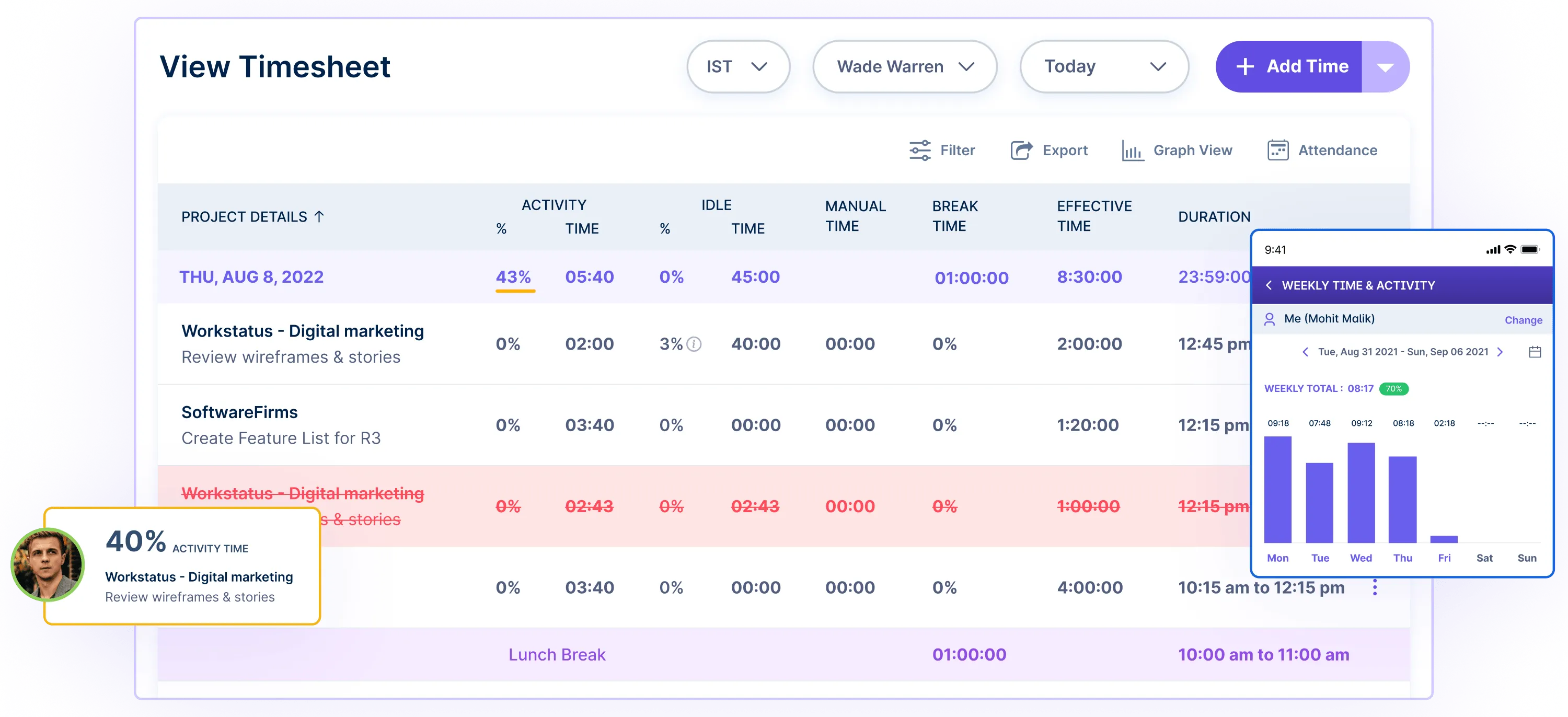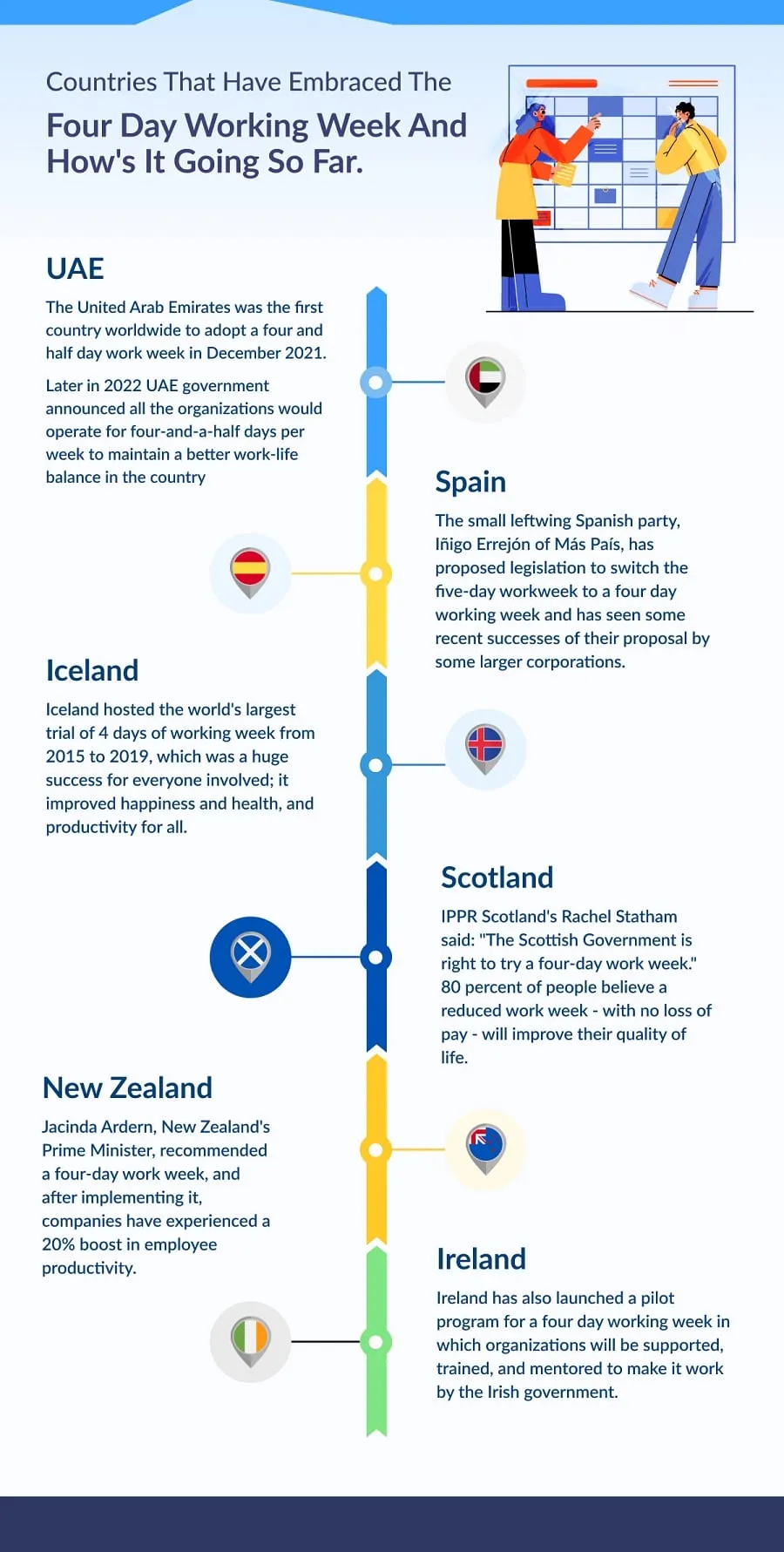Table of Contents
Introduction
In the ever-changing economy of today, there’s one certain thing, and that’s working smarter than harder has become normal.
New cultures, such as working in an open space office, working from home, or building a digital nomad company, all contribute to this new normality.
With technology providing more efficient ways to work, there’s no end to opportunities for people to find out what works best for them.
With ample options, it is up to each person what they feel most comfortable with and how productive they can be with different setups.
One experiment worth mentioning is the four-day working week, where workers are required to work four days instead of 5 with 12 hours a day rather than 9, which makes them satisfied with the fact that they have 3 days off every week and their productivity remains the same.
The rise of the 4 day work week has been fueled by the rise of automation and data analytics, as well as companies’ desire to give their employees more free time outside of work hours, which helps both companies and employees to maintain a healthier lifestyle.
Multiple successful start-ups worldwide are operating solely on a 4 day work week, including Teksavvy, Panasonic, and Google, setting up new standards of maintaining work-life balance with better productivity and growth.
However, as we all know, everything with some benefits also carries disadvantages. The same goes for the 4 days working week as it brings challenges and risks that can affect the company if not managed properly.
In this blog, we will understand the 4 day work week advantages and disadvantages. We will also understand how to make it work for you so that you can make the most out of this working culture.
Let’s dive in-
What is the 4-day Workweek?
A 4-day workweek option can be defined as a work schedule proposal in which employees conduct business activities for 4 days in one week instead of the conventional 5 days. This, however, does not eliminate the various hours that one has to spend at work; it only entails condensing the working hours into fewer days.
For instance, instead of employees working eight hours each day, five days a week, they will now work ten hours each day, four days a week. However, some organizations reduce the total working hours in a week, either or all the above options.
Different Models
- Compressed Workweek: Suppose total working hours are similar to the standard workweek but are condensed into fewer days. For instance, working 10 hours a day for 4 days in a week or 40 hours in a week.
- Reduced Hours: This implies that the overall working hours provided in a specific week are reduced. For instance, the employees could be required to work 32 hours, which are distributed over four days instead of 40 hours.
- Hybrid Models: Regarding flexible working arrangements, it is also important to know that some organizations implement the 4-DWG with home working or flexible working time to meet a company’s needs.
The Rise of the 4-Day Workweek
The concept of working only four days a week is slowly spreading around the global population. This is not only about granting people more free time; it is also about making work more efficient and enjoyable. Various organizations realize that a shorter workweek is a great way of making employees happier and more competent.
Here are some reasons why the 4-day weekend work is catching up:
- Happier Employees
When people work fewer days, they have more time to rest, be with their family, and do things they love. This extra time off reduces stress levels and prevents exhaustion from work. Employees who are happy at work are always more productive or focused, hence enhancing performance.
- Increased Productivity
It has been found that productivity increases when people reduce their work hours. Employees with a four-day workweek are more alert and use most of their time productively. They also take fewer sick leaves since they are less pressured, happier, and healthier than their traditional counterparts.
- Better Work-Life Balance
In this case, a flexible workweek is a four-day workweek that enables employees to balance work and other activities. Employees can attend their events, have their hobbies, and run their errands, thus leading to a more fulfilled life outside the working world. Combined with no conflict, it benefits physical, mental, and social health and long-term career satisfaction.
- Attracting Talent
Employers who propose the 4-day work week are attractive to job candidates. A shorter workweek is another advantage, especially in today’s commerce world, where competition has reached high levels regarding securing employment. This erases the aspect of the employees’ speculation that the company does not care about their welfare, hence improving their hold on the best talents.
- Positive Business Outcomes
As do businesses, employees are also known to benefit from a 4-day work week. Less stress and higher satisfaction mean decreased employee turnover, which minimizes costs associated with recruiting and training. Further, a happy workforce that is seemingly more skillful and focused is definitively more effective, which can improve the overall team performance.
Common Challenges Of A 4-Day Workweek
Here are some common challenges of a 4-day workweek:
- Potential for Increased Workload
Reducing the time from five days to four means longer working hours and more work per day, which, if poorly planned, may lead to higher stress and rates of employee burnout.
- Customer and Client Service Issues
Some businesses, such as health facilities and retail shops that rely on constant service provision, might face challenges in meeting the expected service standards. It may be necessary to perform work in shifts or coordinate working days, which can be challenging.
- Implementation Challenges
Moving to an expanded 4-day workweek requires setting up, and redesigning workflows and Opposition from those who fret over efficiency and power.
- Uneven Benefits Across Sectors
The four-day workweek may be adequate for white-collar workers but may not be practical in blue-collar and service sectors. Some workers may not receive these benefits to the same extent due to the nature of their work arrangements. Part-time and gig economy workers, for example, may need sector-specific modifications.
- Legal and Regulatory Considerations
The lack of a legal basis for a four-day workweek means that current labor laws and contracts might contain provisions that do not allow such an organization to implement the policy to deal with overtime and compensation issues appropriately.
- Communication and Collaboration Issues
Less working days make it difficult to arrange meetings and propose strategies for the crew’s coming together, especially for the international crews. Organization and implementation of all resources and technologies are critical to effective planning.
3 Pros of 4-day Workweek
Many companies are abandoning the conventional 9-to-5 schedule and moving towards a four-day workweek or other compressed schedules. It also appears that employees are getting the better end of the deal.
Reducing the number of hours worked within a week may also improve productivity because people with more days off are more satisfied with their work. Moreover, the organizations where these workers are employed have lower weekly working hours than other organizations, and the workers are more productive.
- Happier and More Satisfied Employees
It also reduces turnover as researchers have found that workers who work 4 days a week hardly contemplate switching employers, which is cost-saving.
Furthermore, they report reduced stress levels, as they are off three days a week, which is sufficient for the rest of the week.
They are happier with their careers because they can practice proper health habits, which produces better results than working five days a week.
Furthermore, happier and more satisfied employees perform better by delivering quality work and sharing better ideas to improve and increase a company’s competitiveness.
- Higher Productivity
Suppose your company faces competitiveness issues or difficulty achieving certain business objectives, such as cutting operational costs while enhancing profitability. In that case, the solution is as simple as shifting to a four-day working week schedule.
One can observe that such employees are often more productive and do more work during the day because they have an extra week to rest and devote time to necessary tasks such as chores or shopping.
Shorter work days are compensated for efficiency and output to achieve and sometimes surpass their earlier project turnover rates.
- Better Work-Life Balance
Whenever it is implemented, a four-day workweek means that workers can be off for three days in the middle of the week, thus getting time to do their hobbies, be with the family, or do chores at home.
They can even read books or just go out for coffee, which allows them to start the next working week with a healthy mind and body. They adopt healthier lifestyles instead of working on the weekend and burning out.
Also, improved work-life balance generates better employee satisfaction and decreased burnout levels, which results in more satisfied employees and lower turnover rates.
3 Cons Of 4-Day Workweek
Supporters of a four-day workweek state that this increases free time, time with friends and family, and, therefore, time for hobbies and exercise, all of which are positive.
However, there are also some negatives to this, especially if one has to come to work only four days a week. For this reason, before you introduce the four-day workweek concept, the following are three major drawbacks that should be balanced against a new, absolutely free day in the middle of the week.
- You Work Longer Hours Than Usual
Mondays to Fridays are the working week, meaning you must make up the extra hours daily to accomplish what you need when you work four days a week.
Such additional time and commitment may result in additional stresses and a higher likelihood of burnout that can potentially reduce the effectiveness of employees in this company and the quality of the material they produce, causing a decreased efficiency on the whole.
3.More Challenges In Setting Up Of Routines
One of the main grievances when working four days a week is how practically impossible it is to have a daily routine when time is as crucial as it is in the modern world.
With an increase in the number of hours worked in a day, one has to work very late into the night to complete whatever is necessary in a day.
This causes fluctuations in certain schedules, such as the wake-sleep cycle, which definitely has adverse effects on the body’s well-being and can lead to several illnesses. In essence, this lowers efficiency and productivity.
These were the pros and cons of a four-day workweek. Next, let’s cover how to manage a four-day workweek.
3 Tips For Managing Your 4-Day Workweek
Setting up a 4-day working week can seem like a daunting task to get started with, but here are some tips to help you manage your new schedule.
1. Set Time Limits
It’s essential to set time limits for tasks and projects and carve out blocks of time where you can relax, as this will allow your employees to meet deadlines while also maintaining a sense of balance.
Employers can use time-tracking software such as Workstatus to track the time spent by their employees on every task and ensure that they’re completing their projects promptly and achieving maximum productivity and output.

2. Prioritizing
Making the switch to a 4-day workweek does not mean the workload of the employee changes, nor should it.
With less time available, it becomes critical to prioritize and identify which tasks need to be completed urgently and which can wait until tomorrow.
Setting specific goals and breaking them down into smaller objectives will also go a long way toward achieving maximum output during shorter workdays.
This way, employees can still accomplish everything they need during the week and feel accomplished after putting in their best effort.
3. Establish Routines
When it comes to establishing a 4-day workweek, employers must be mindful that it can take time for employees to adjust and find a rhythm.
To prevent disruptions in their daily routine and sleep patterns, managers should provide ample opportunities for their employees to adjust and transition gradually.
For instance, the company can start by gradually introducing a 4-day workweek over several weeks before finally implementing this type of work culture as the standard.
Employees also need to understand that they still need to accomplish everything they usually do within shorter workdays, so establishing habits early on will be key to sustaining productivity in the long run.
Final Thoughts
The four-day workweek is the new normal. As a company, you need to decide whether or not you want to be on the ground floor of this change or risk being left behind.
There are many benefits and drawbacks of moving towards a four-day workweek, which is essential to consider before implementing such a shift as it will significantly impact your employees individually and as a team.
However, with the right planning in place, it could prove to be an extremely worthwhile investment, so it’s up to you to weigh the pros and cons of four day work week and make a decision that is best for your business.
That’s all for today
We hope you’ve found our blog post insightful.
If you have any comments or suggestions, please don’t hesitate to leave them below. We would love to answer your queries.
In addition, small businesses are usually able to handle a change easier than larger corporations since they have more room for flexibility and can adapt quickly.
Don’t forget to share this post with others who may benefit from the information.
We will catch you soon.
Until then, keep learning.
Thank You!













